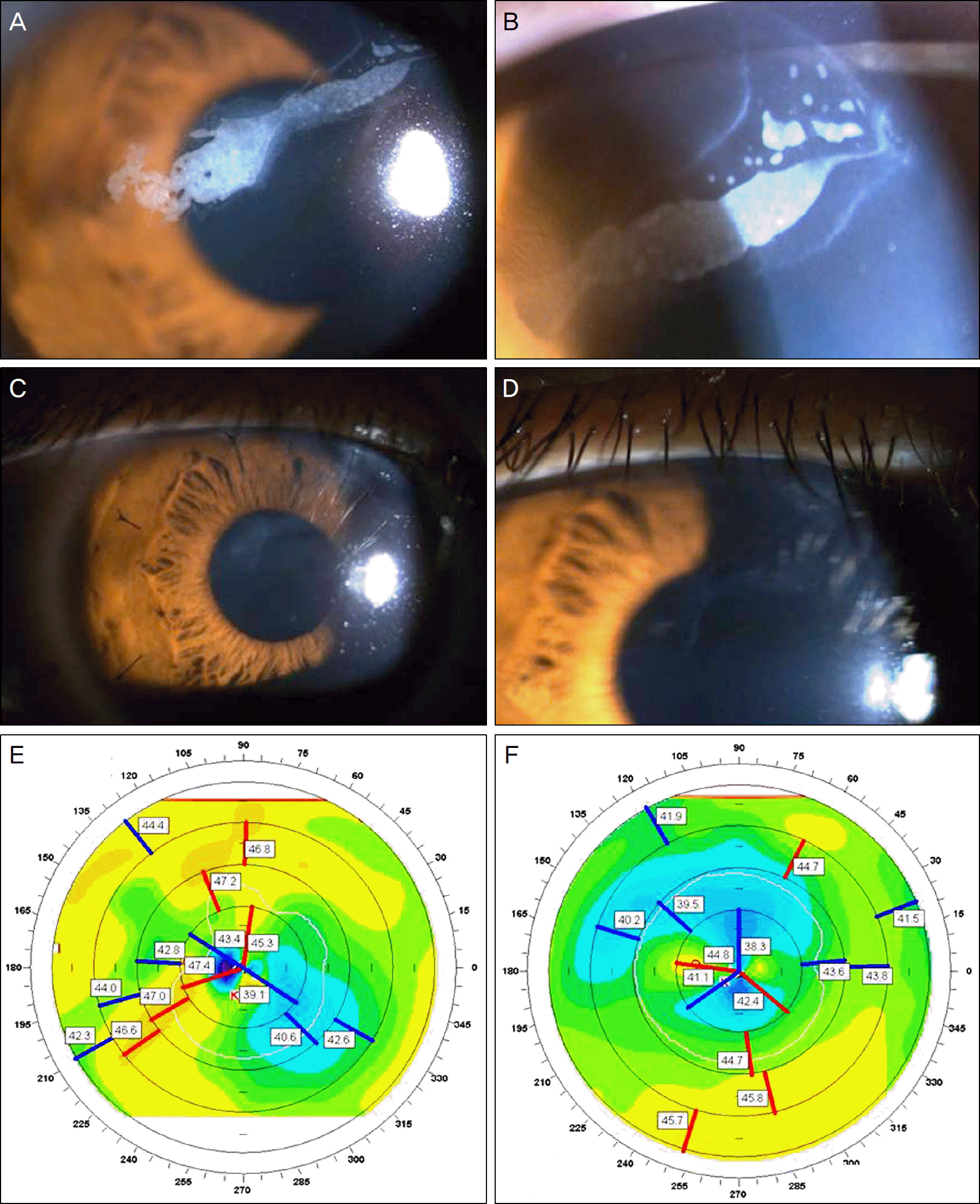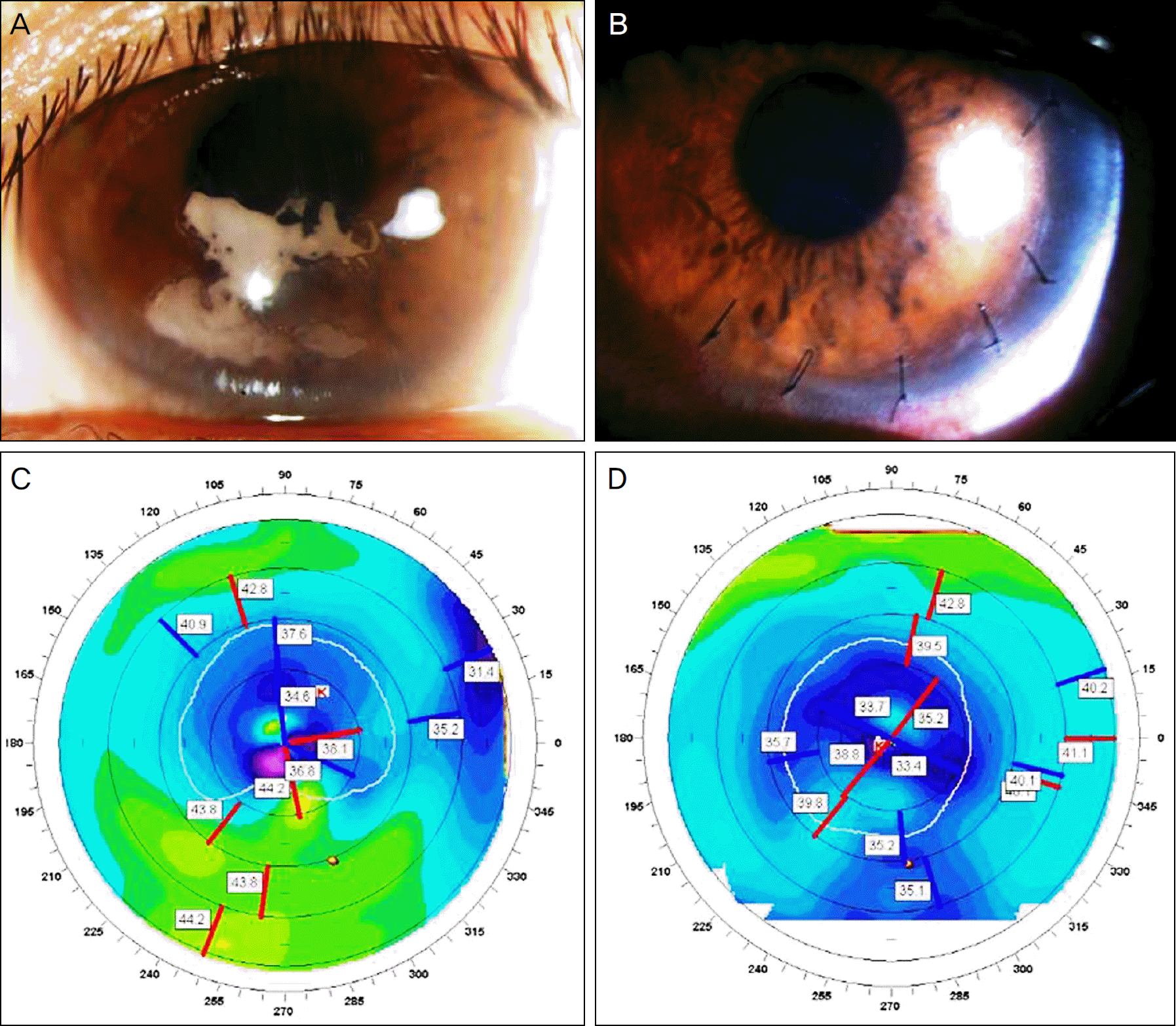Abstract
Purpose
To report 2 cases of thick, lateonset and long-standing epithelial ingrowth after laser-assisted in situ keratomi-lusis (LASIK) using mitomycin C-assisted photorefractive keratectomy and flap suturing.
Case summary
The first case involved a 29-year-old woman who had LASIK in both eyes in 2002. She was diagnosed with epithelial ingrowth OD after blunt ocular trauma in 2007. The second case involved a 30-year-old man who had LASIK in both eyes in 1999 followed by enhancements in 2004. Slit lamp examination showed dense epithelial ingrowth OS in a geographic pattern. Two eyes of the 2 patients with epithelial ingrowth had flap lifting followed by debridement of interface epithelial cells, photorefractive keratectomy, interface application of mitomycin C, and the placement of interrupted 10–0 nylon sutures. Two eyes regained better uncorrected visual acuity and showed reduced corneal astigmatism postoperatively. There was no evidence of residual or recurrent ingrowth throughout the follow-up period (case 1: 11 months, case 2: 1 month).
Go to : 
References
1. Rapuano CJ. Management of epithelial ingrowth after laser in situ keratomileusis on a tertiary care cornea service. Cornea. 2010; 29:307–13.

2. Domniz Y, Comaish IF, Lawless MA, et al. Epithelial ingrowth: causes, prevention, and treatment in 5 cases. J Cataract Refract Surg. 2001; 27:1803–11.

3. Naoumidi I, Papadaki T, Zacharopoulos I, et al. Epithelial ingrowth after laser in situ keratomileusis: a histopathologic study in human corneas. Arch Ophthalmol. 2003; 121:950–5.
4. Anderson NJ, Hardten DR. Fibrin glue for the prevention of epithelial ingrowth after laser in situ keratomileusis. J Cataract Refract Surg. 2003; 29:1425–9.

5. Spanggord HM, Epstein RJ, Lane HA, et al. Flap suturing with proparacaine for recurrent epithelial ingrowth following laser in situ keratomileusis surgery. J Cataract Refract Surg. 2005; 31:916–21.

6. Fagerholm P, Molander N, Podskochy A, Sundelin S. Epithelial ingrowth after LASIK treatment with scraping and phototherapeutic keratectomy. Acta Ophthalmol Scand. 2004; 82:707–13.

7. Taneri S, Koch JM, Melki SA, Azar DT. Mitomycin-C assisted photorefractive keratectomy in the treatment of buttonholed laser in situ keratomileusis flaps associated with epithelial ingrowth. J Cataract Refract Surg. 2005; 31:2026–30.

8. Ambrósio R Jr, Wilson SE. Complications of laser in situ keratomileusis: etiology, prevention, and treatment. J Refract Surg. 2001; 17:350–79.

9. Leung AT, Rao SK, Cheng AC, et al. Pathogenesis and management of laser in situ keratomileusis flap buttonhole. J Cataract Refract Surg. 2000; 26:358–62.

10. Asano-Kato N, Toda I, Hori-Komai Y, et al. Epithelial ingrowth after laser in situ keratomileusis: clinical features and possible mechanisms. Am J Ophthalmol. 2002; 134:801–7.

11. Kamburoğ lu G, Ertan A. Epithelial ingrowth after femtosecond laser-assisted in situ keratomileusis. Cornea. 2008; 27:1122–5.
12. Wang MY, Maloney RK. Epithelial ingrowth after laser in situ keratomileusis. Am J Am J Ophthalmol. 2000; 129:746–51.

13. Kim SW, Byun YJ, Kim EK, Kim TI. Treatment of epithelial ingrowth after laser in situ keratomileusis using amniotic membrane patch. J Korean Ophthalmol Soc. 2007; 48:230–7.
14. Zhao LQ, Wei RL, Ma XY, Zhu H. Effect of intraoperative mitomycin-C on healthy corneal endothelium after laser-assisted subepithelial keratectomy. J Cataract Refract Surg. 2008; 34:1715–9.

15. Kim ES, Jin KH. Evaluation of the prophylactic use of mitomycin to inhibit haze formation after LASEK. J Korean Ophthalmol Soc. 2007; 48:623–9.
16. Verweij J, Pinedo HM. Mitomycin C: mechanism of action, usefulness and limitations. Anticancer Drugs. 1990; 1:5–13.
Go to : 
 | Figure 1.Patient 1 has linear pattern epithelial ingrowth under the superonasal part of the corneal flap (A). The connection was observed between the epithelial Island and the flap edge without overlying melting of the flap edges (B). Two weeks after removal of the epithelial ingrowth, there is no evidence of residual or recurrent ingrowth but there is mild interface haze (C). Eleven months after surgery, there is no evidence of recurrent ingrowth (D). Epithelial ingrowth was elevating the flap and Orbscan corneal topograph showing irregular astigmatism (E). Eleven months after surgery, the topography is not regular but extensively changed and showed reduced corneal astigmatism postoperatively (F). |
 | Figure 2.Patient 2 has island of the central epithelial ingrowth expanding toward the visual axis on the inferior margin of the pupil (A). Two weeks after removal of the epithelial ingrowth Patient 2 has mild interface haze but no residual or recurrent ingrowth (B). Extensive epithelial ingrowth was elevating the flap and Orbscan corneal topograph showing irregular astigmatism (C). More than 1 week after surgery, the topography is not regular but extensively changed and showed reduced astigmatism postoperatively (D). |




 PDF
PDF ePub
ePub Citation
Citation Print
Print


 XML Download
XML Download